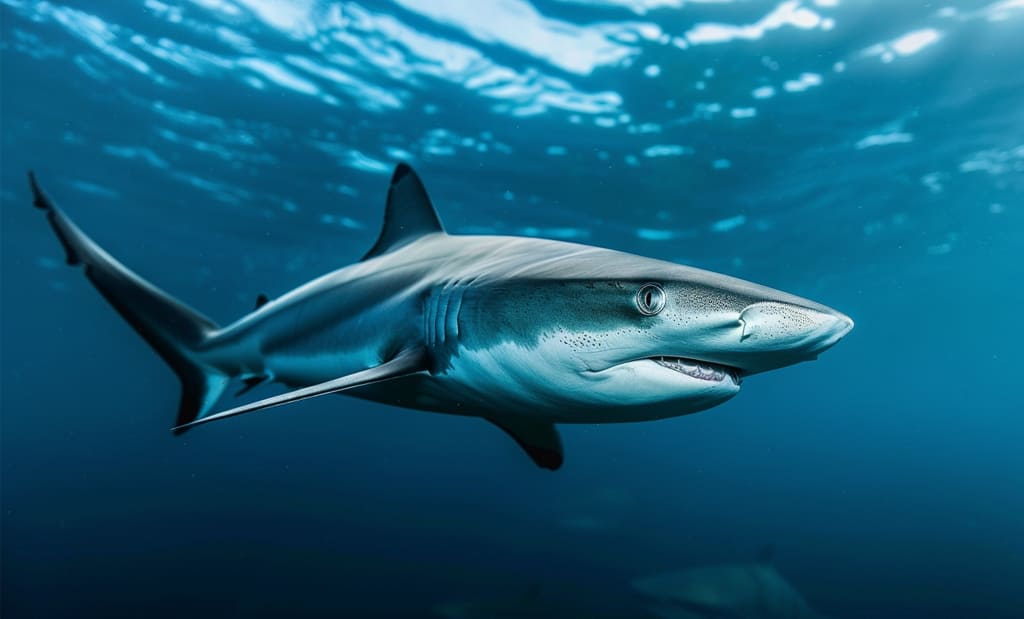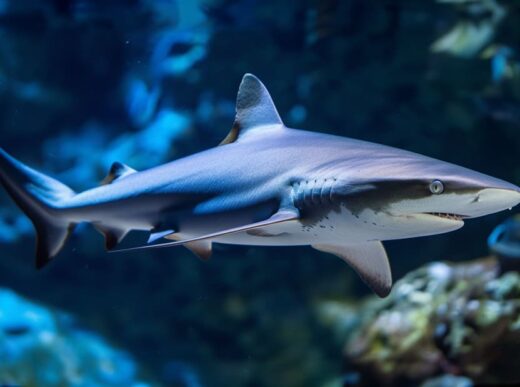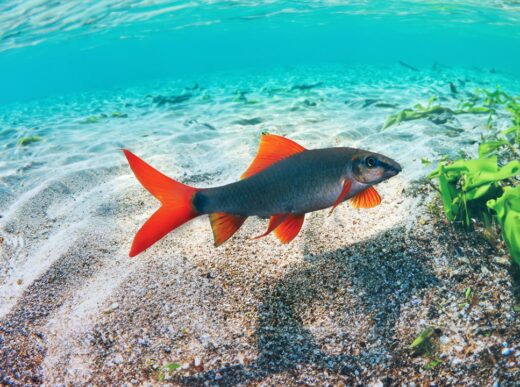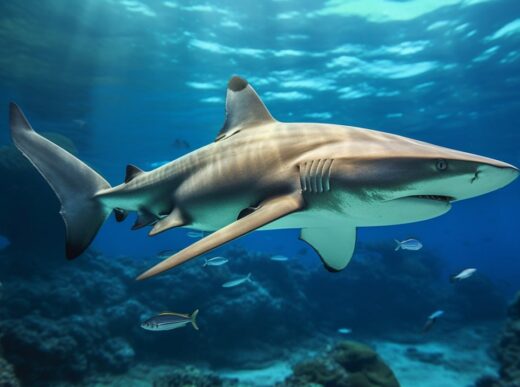Plunge into the mesmerizing depths of the ocean with us as we unveil the captivating world of blue sharks! These creatures stand out as the most famous and abundant sharks in the ocean. We’ve assembled 20 fun and intriguing facts that will offer you a fresh perspective on these oceanic wonders.
20 Amazing Facts About Blue Sharks
Strap in for an exhilarating ride through the mysterious waters where sharks reign supreme! Join me as we dive into the incredible world of their awe-inspiring features.
Characteristics
1. Quick reminder: blue, blue, and great blue sharks all refer to the same species, and for simplicity, we’ll just call it the blue shark. Interestingly, the ancient word «Mokoi» is associated with this shark.
2. Now, scientists have bestowed the formal name Prionace glauca upon this marvelous shark, and it translates to «grey and straight.» The blue shark is indeed part of the Grey shark family, forming its only genus.
3. Wrap your head around this – the blue shark can grow up to a whopping 3.8 meters and tip the scales at 200 kilograms! A pregnant female even set a record at 391 kilograms.
4. Picture this: a truly stunning shark with sleek body contours, a dorsal fin set back from the snout, and remarkably long lateral fins.
5. True to its name, the blue shark lives up to its color palette. Its back sports a vibrant blue hue that lightens towards the sides, while the belly stays pristine white – a common trait among many sharks.
6. Brace yourself for this amazing tidbit: the blue shark boasts an unusually keen sense of smell, capable of detecting prey from several kilometers away. It’s like having a built-in GPS for hunting in the vast ocean!
Habitats
7. Get ready for some incredible news – the blue shark takes the crown as the most common shark on the planet! It’s a true globe-trotter, calling the Pacific, Indian, and Atlantic Oceans home. From coastal waters to the open sea, you can spot this shark almost everywhere.
8. The blue shark doesn’t fancy the deep-sea lifestyle; it’s more of a surface dweller, seldom venturing beyond 350 meters below. This shark isn’t a fan of chilly high-latitude waters either, as it relies on external sources for the majority of its body heat. It’s like the ultimate ocean explorer, cruising the world’s waters with ease!
Lifestyle
9. Brace yourself for this jaw-dropping fact – the blue shark can hit speeds of up to 60 kilometers per hour! With such lightning-fast agility, hardly any prey stands a chance of dodging its rapid attack.
10. The blue shark is a true hustler, hunting tirelessly day and night, never hitting the brakes, and always on the move. It’s like the ocean’s perpetual motion machine, constantly on the lookout for its next meal!
Eating Habits
11. It’s time to dispel any myths about sharks being picky eaters – blame it on the blue shark! This shark is an absolute opportunist, devouring anything that crosses its path! Whether it’s fish, mollusks, or crabs, the blue shark’s menu is quite diverse. But here’s the catch – it’s not above greedily snapping up garbage discarded from ships.
12. This shark’s knack for mischief extends to taking advantage of others’ hard work. Picture this: blue sharks making a move on the catch ensnared in fishing nets. There have been cases where these sharks were hoisted onto trawlers’ decks along with the nets, unwilling to let go of their prize. Talk about making a meal out of someone else’s catch!
Intelligence and Social Behavior
13. While the blue shark typically leads a solitary lifestyle, it’s not shy about teaming up with fellow sharks when hunting. Strength in numbers, right? They form packs to corral schools of fish, ensuring a more successful and cooperative hunting expedition. Teamwork makes the dream work, even for sharks!
Reproduction
14. Wrap your head around this astonishing fact – the blue shark is among the most prolific of all sharks, with litters numbering up to a whopping 60 pups!
15. The blue shark takes the egg-laying route to parenthood. The pups hatch within the womb, sustaining themselves on the yolk until it’s time for their grand entrance into the world. Talk about a cozy start! A blue shark’s pregnancy journey spans up to a whole year. It’s like a marine marvel of reproduction!
Population
16. The blue shark keeps its population size under wraps, and while it’s thought to be among the largest shark populations, there’s a catch. Extensive commercial fishing has made this shark vulnerable, leading to a decline in numbers despite its impressive birth rates. It’s like a cautionary tale of the delicate balance in the vast ocean ecosystem. Let’s hope these swift swimmers can weather the storm!
Danger To Humans
17. Believe it or not, despite its voracious appetite, the blue shark is not deemed a significant threat to humans. Its rare interactions with humans occur far from coasts and beaches.
18. The real danger to the blue shark comes from us humans. Rampant harvesting for its meat, fins, and skin poses a grave threat to this species. Shockingly, up to 20 million sharks, including the blue shark, face this perilous fate each year. It’s a stark reminder of the impact our actions can have on the intricate balance of marine life.
Are There Any Aquariums with Blue Shark?
19. Absolutely fantastic news! Spotting a blue shark is a breeze—these ocean wanderers often cruise the open sea, steering clear of the shoreline. Your best bet for a front-row seat? Hop on a yacht or boat, where you can frequently observe these majestic creatures in their natural habitat.
20. Now, onto the not-so-great news: glimpsing a blue shark in an aquarium is a tough nut to crack. These aquatic nomads aren’t the biggest fans of captivity. If, by chance, you come across one enduring life in an oceanarium, consider it a rare spectacle. The record-holder for captivity longevity? An impressive 873 days!
And if you’re yearning for an aquarium encounter with blue sharks, Japan is the place to be. There, one oceanarium stands out, regularly showcasing these incredible denizens of the deep.
Sendai Uminomori Aquarium (Sendai, Japan):
- Website: Sendai Uminomori Aquarium
Checking the official websites or directly contacting aquariums is the best way to ensure you have the latest and most accurate information on exhibits, including the presence of blue sharks. Exhibits can undergo changes, and aquariums may introduce new species or displays over time. Always stay updated for the most enjoyable and informative experience!




